Part 8: The 2012 Wilson Research Group Functional Verification Study
Language and Library Trends
This blog is a continuation of a series of blogs that present the highlights from the 2012 Wilson Research Group Functional Verification Study (for a background on the study, click here).
In my previous blog (Part 7 click here), I focused on some of the 2012 Wilson Research Group findings related to testbench characteristics and simulation strategies. In this blog, I present design and verification language trends, as identified by the Wilson Research Group study.
You might note that for some of the language and library data I present, the percentage sums to more than one hundred percent. The reason for this is that some participants’ projects use multiple languages.
RTL Design Languages
Let’s begin by examining the languages used for RTL design. Figure 1 shows the trends in terms of languages used for design, by comparing the 2007 Far West Research study (in gray), the 2010 Wilson Research Group study (in blue), the 2012 Wilson Research Group study (in green), as well as the projected design language adoption trends within the next twelve months (in purple) as identified by the study participants. Note that the design language adoption is declining for most of the languages with the exception of SystemVerilog whose adoption continues to increase.
Also, it’s important to note that this study focused on languages used for RTL design. We have conducted a few informal studies related to languages used for architectural modeling—and it’s not too big of a surprise that we see increased adoption of C/C++ and SystemC in that space. However, since those studies have (thus far) been informal and not as rigorously executed as the Wilson Research Group study, I have decided to withhold that data until a more formal blind study can be executed related to architectural modeling and virtual prototyping.
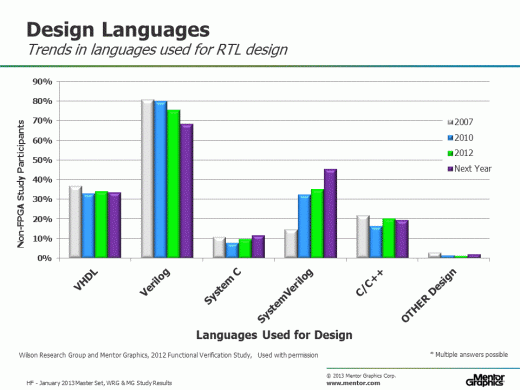 Figure 1. Trends in languages used for Non-FPGA design
Figure 1. Trends in languages used for Non-FPGA design
Let’s now look at the languages used specifically for FPGA RTL design. Figure 2 shows the trends in terms of languages used for FPGA design, by comparing the 2012 Wilson Research Group study (in red) with the projected design language adoption trends within the next twelve months (in purple).
Figure 2. Languages used for Non-FPGA design
It’s not too big of a surprise that VHDL is the predominant language used for FPGA RTL design, although we are starting to see increased interest in SystemVerilog.
Verification Languages
Next, let’s look at the languages used to verify Non-FPGA designs (that is, languages used to create simulation testbenches). Figure 3 shows the trends in terms of languages used to create simulation testbenches by comparing the 2007 Far West Research study (in gray), the 2010 Wilson Research Group study (in blue), and the 2012 Wilson Research Group study (in green).
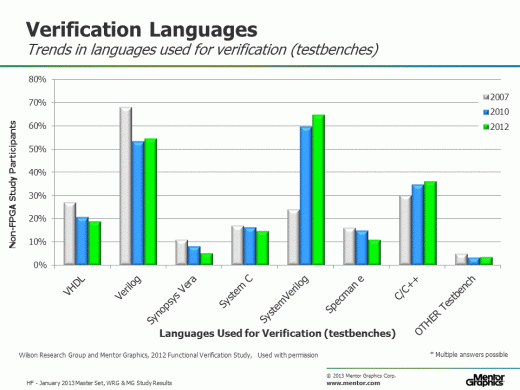 Figure 3. Trends in languages used in verification to create Non-FPGA simulation testbenches
Figure 3. Trends in languages used in verification to create Non-FPGA simulation testbenches
The study revealed that verification language adoption is declining for most of the languages with the exception of SystemVerilog whose adoption is increasing. In fact, SystemVerilog adoption increased by 8.3 percent between 2010 and 2012.
Figure 4 provides a different analysis of the data by partitioning the projects by design size, and then calculating the adoption of SystemVerilog for creating testbenches by size. The design size partitions are represented as: less than 5M gates, 5M to 20M gates, and greater than 20M gates. Obviously, we find that the larger the design size, the greater the adoption of SystemVerilog for creating testbenches. Yet, probably the most interesting observation we can make from examining Figure 4 is related to smaller designs that are less than 5M gates. Here we see that 58.8 percent of the industry has adopted SystemVerilog for verification. In other words, it is safe to say that SystemVerilog for verification has become mainstream today and not just limited to early adopters or leading-edge design projects.
Figure 4. SystemVerilog (for verification) adoption by design size
Let’s now look at the languages used specifically for FPGA RTL design. Figure 5 shows the trends in terms of languages used for FPGA design, by comparing the 2012 Wilson Research Group study (in red) with the projected design language adoption trends within the next twelve months (in purple).
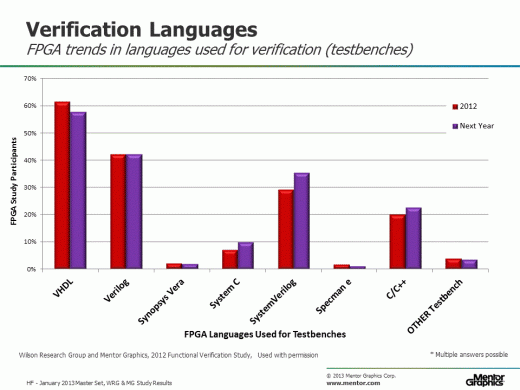 Figure 5. Trends in languages used in verification to create FPGA simulation testbenches
Figure 5. Trends in languages used in verification to create FPGA simulation testbenches
In my next blog (click here), I’ll continue the discussion on design and verification language trends as revealed by the 2012 Wilson Research Group Functional Verification Study.
Comments
Leave a Reply
You must be logged in to post a comment.
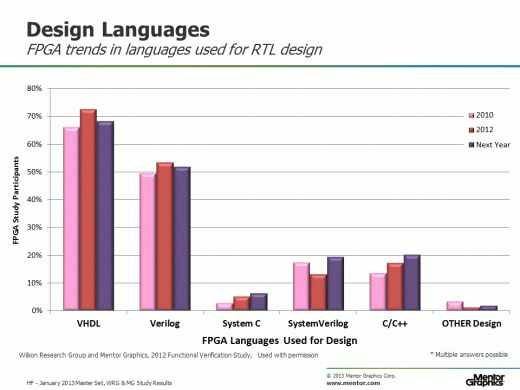
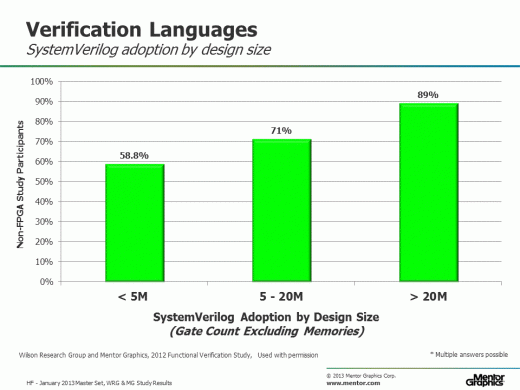



Minor typo on figure #2 caption. Should be: Figure 2. Languages used for FPGA design (instead of non-FPGA design). I always enjoy reading these study results.
Hi, Harry – do you still have a pending posting on verification methodology usage trends? OVM / UVM / Specman / etc.??
Thanks Cliff for the typo.
And yes, next week I will release methodology adoption and assertion language adoption.